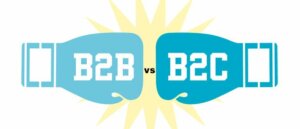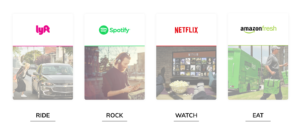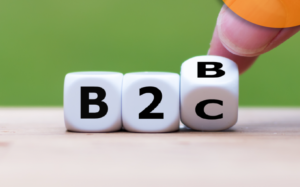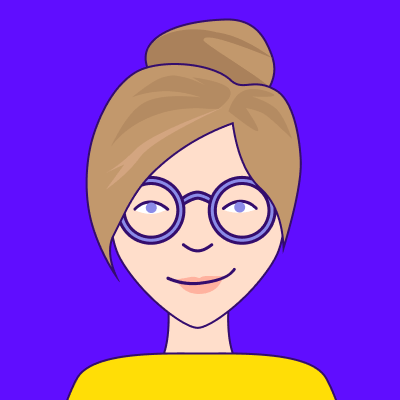How much do you love that bot on your favorite e-commerce site that browses the store for you to spoon-feed you items similar to your latest purchases? How much easier does it make your shopping experience when your service provider hands you insights about your shopping habits and interests? It saves time and effort and it’s oh so spot on!
This, my friends, is B2C sales 2.0 and its buy-in from customers is so infectious that B2B sales are taking notice and following suit.
In this post, we’ll deep dive into the ins and out of B2B and B2C sales processes, how they differ and how they aim to be more alike, and answer the questions on the minds of so many in the SaaS space – can a B2B product be sold with a B2C approach? Can B2C tactics be applied to B2B prospecting?

What is B2C Sales
B2C sales can refer to any sales process that sells directly to end-users. This can include brick-and-mortar establishments and e-commerce sites. In this sales model, businesses target individual consumers, personalizing their pitch so that it fits perfectly with their prospective clients.
By and large, B2C sales are characterized by lower deal sizes, shorter sales cycles, and larger volumes of end-users.
Today’s B2C consumers have grown to expect instantaneously personalized buying experiences. Features like personalized recommendations, customized outreach, easy checkout processes, and insight collection have become industry standards in the B2C space. Popular B2C brands like Netflix, Amazon and Spotify have transformed sales and created a new breed of customer by giving users exactly what they want, when they want it.

B2B Sales Strategy
By contrast, B2B sales refers to either Software as Service (SaaS) or cloud services which are sold to companies rather than individual customers. In this sales model, businesses correspond with other businesses culminating in large deal sizes, usually for prolonged periods of time with opportunities for growth, upsell, and extended use.
B2B sales are generally characterized by longer sales cycles, slowly easing companies into adopting new software, and lower volumes of customers. They often require deeper sales intelligence and prospecting processes. Because accounts tend to be higher tickets, often in the six figure range and upwards, much fewer are needed to generate revenue.
Yet when we talk about B2B sales strategy and the B2B sales experience, we must adopt a before and after look. B2B has been undergoing a gradual awakening in the past decade or so, becoming progressively more customer-focused than it had ever been before and adopting several key B2C staples in the process.
B2B’s strategy is fast going in the direction of a hybrid model. One that integrates and merges oldschool B2B staples like cold calling, attendance at trade shows and events, and lead forms, with B2C staples like personalized outreach, product-first approach and self-serve models.
Difference Between B2B and B2C Selling
As we lay out the various areas in which B2B and B2C differ, we’ll see that what is at play between the two disciplines is not a ‘one against the other’ but a ‘one after the other’ dynamic. Let’s dive in.

1. Product Lead Growth
It used to be that the greatest differentiator between B2B and B2C was their approach to product. While B2C sites were easy to navigate and user friendly, B2B sites were notoriously complicated and inaccessible.
B2Cs placed no entrance barriers, allowing immediate access to their assets and no browsing restrictions. B2Bs, on the other hand, were tucking away their product behind lead forms.
Then the Product Lead Growth movement (PLG) hit the B2B scene and turned this model on its head. PLG opened up all barriers that stood between the user and the product, and allowed free access to the product with no commitment upfront. The product itself, said the Product Led aficionados, would become the driver for sales.
What used to be the sole domain of B2C was now becoming critically important for B2B companies, driving their acquisition, conversion and expansion.
“We can now safely say that Product Led Growth has broken the silos of B2B and B2C and is facilitating robust sales funnels across both business models.” Amanda Kleha, CCO at Figma
2. Self-Serve
“Self-serve is becoming the norm in B2B sales, not only because B2B is increasing its sales volumes but also because that’s what customers are used to from their personal B2C dealings and they want the same ‘quick and easy’ when they purchase software.” Forrester Report on Future of B2B Sales, 2020
The high account volumes of B2C have historically necessitated a zero-touch sales model and have led to the rise of the self-serve.
B2B was slow to get on the self-serve bandwagon for a variety of reasons including its more complex product offerings and lagging technology solutions. But with B2B’s gradual move to higher volumes of clients, it became a necessity to go self-serve as a scalable model. Simply, high-touch accounts and high sales-intensiveness could not be done at scale.
Yet beyond the practical need for self-service implicit in increasing customer volumes, consumers have always wanted more control over the sales process. This is no different in B2B than it is in B2C.
When B2Cs started placing the product and pricing upfront, they essentially put the decision making process in the hands of the users. And the users loved it. They liked trying the product rather than being sold on the product, they liked testing it themselves rather than being demoed on it.
This transformed the way we interact with products and set a new standard which B2Bs have to live up to if they are going to stay in the game.
3. Ease of Use
“Buying software should be as quick and easy as buying a shirt. You browse around and find what you like, then you try it on and if it looks and feels good – you buy it. You’re not going to test drive a shirt. You’re not going to subscribe to try it on.” Lusha CEO, Yoni Tserruya
When it comes to B2C, simplicity and ease of use have always been determining factors for success. But B2B has been synonymous with complexity, complicated installments and lengthy onboarding for so long that when SaaS companies try to adopt ease and simplicity as one of their qualities it almost sounds unbelievable.
This is because the issue of simplicity warrants clarification: there is a difference between the level of technological sophistication on the backoffice side, and the customer facing side which consumers interact with. When it comes to ease of use, what matters is the UI.
Especially because B2B consumers approach products with an innate suspicion towards claims of simplicity, the ease of use needs to be tangible on first glance. The plug-and-playability needs to work on first try. When it does, when a B2B manages to make its product truly simple and easy to use, the buy-in from users is unbeatable.
4. Personalization
The goal of a personalized sales strategy is to leave the customer with a positive experience that distinguishes a brand from its competition. If successful, personalization becomes a unique selling point; a value proposition that you are willing to make the effort to get to know your customer.
This may start with adding a customer’s name to the subject line of an email, but it can’t end there. True personalization follows throughout the sales funnel and increases as the user intent grows. When you log into Netflix or Amazon for example, immediately customized recommendations surface based on your order history and browsing behavior.
While customization has long been a classic sales strategy for B2Cs, it is fast becoming a critical element for determining purchase intention in B2B sales as well. As B2Bs become increasingly involved in the customer journey, so too are they seeing the impact of a ‘connected journey’ on sales revenue.
Wrap Up – So What is B2B Adopting from B2C?
Want to test the product? Fill out a form, book a demo.
Want to get a quote: Fill out a form, wait for a sales call.
Have more questions: Fill out a form, and wait.
Sound familiar?
It’s outdated and out of sync with the simplicity and accessibility of B2C interfaces, but this is still how many B2Bs do sales. Unfortunately, it’s not easy to transition B2B’s complex products and winding sales cycles into the plug-and-play generation.
The hook is always the lure of increased sales. B2Bs need to be reminded that sales processes get optimized the shorter the time between a buyer’s intent and actions gets. And the way to shorten this window is through B2C practices.
PLG, self-Serve, simplifying, streamlining and shortening the sales funnel, letting the customers come to you and personalizing your communication with them – I don’t have a crystal ball, but i’m willing to bet this is the future of B2B sales.
